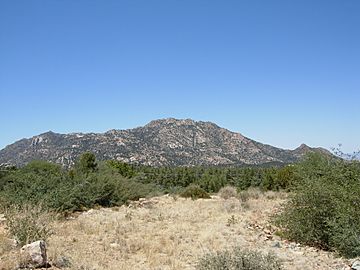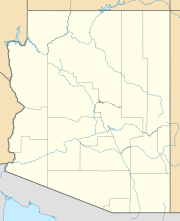Granite Mountain (Arizona) facts for kids
Quick facts for kids Granite Mountain |
|
|---|---|
 |
|
| Highest point | |
| Elevation | 7,628 ft (2,325 m) NAVD 88 |
| Prominence | 1,666 ft (508 m) |
| Naming | |
| Native name | Error {{native name}}: an IETF language tag as parameter {{{1}}} is required (help) |
| Geography | |
| Location | Yavapai County, Arizona, U.S. |
| Parent range | Sierra Prieta |
| Topo map | USGS Jerome Canyon |
| Geology | |
| Age of rock | Proterozoic |
| Mountain type | Granite |
| Climbing | |
| Easiest route | rock climb |
Granite Mountain, also known as Yavapai: ʼWi:kvte:wa in the Yavapai language, is a tall mountain in Yavapai County, Arizona. It reaches 7,628 feet (2,325 meters) high and covers about 12 square miles (31 square kilometers).
Long ago, it was called Mount Gurley. This name honored John A. Gurley, who was the first governor of the Arizona Territory. One side of the mountain has a huge granite cliff. It's about 500 feet (150 meters) tall. This cliff is a very popular spot for rock climbing in Arizona.
Granite Mountain is part of the Granite Mountain Wilderness area. This special area is looked after by the Prescott National Forest. The mountain sits at the northern end of the Sierra Prieta mountains. To its west is Skull Valley, and to its east is Williamson Valley.
Contents
How Granite Mountain Formed
Granite Mountain is mostly made of a type of rock called granodiorite. Geologists call this specific rock the Mint Wash Granodiorite. This rock formed a very, very long time ago. It is from the Paleoproterozoic era, which was about 1.68 billion years ago.
The Mint Wash Granodiorite is a type of granite. It has medium to large grains. You can see crystals of pink or gray potassium feldspar up to 3 centimeters (1.2 inches) long. It also contains small flakes of a dark mineral called biotite.
This granite formed deep underground. It was once hot, melted rock (magma). This magma pushed its way into older rocks. When it cooled down slowly, it became the hard granite we see today. Geologists call this body of rock the Mint Wash Pluton.
What Rocks Are Around Granite Mountain?
The Mint Wash Pluton pushed into different kinds of older rocks. These include sedimentary rocks like mudstone, siltstone, and sandstone. These rocks were once soft sediments that hardened over time.
There are also metavolcanic rocks. These are rocks that were once lava flows from volcanoes. They changed over time due to heat and pressure. Some rocks found here might have formed from minerals that settled out of ancient ocean water.
On the southern side of Granite Mountain, the pluton pushed into other volcanic rocks. These include basalt lava flows and different types of gabbro. Gabbro is another kind of igneous rock.
Ancient Earth Movements
The rocks around Granite Mountain are very old. They are part of the Yavapai tectonic province. This area was once a series of volcanic islands. These islands were like the ones we see today in places like the Aleutian Islands or the Philippines.
These volcanic islands formed where Earth's plates were pushing together. This process is called subduction. Later, these island chains crashed into each other and into the ancient continent of Laurentia. This happened about 1.7 to 1.66 billion years ago. These huge collisions helped form the land we see today.
Animals and Plants of Granite Mountain
Granite Mountain is home to many different plants and animals. You can find forests with pine trees and juniper trees. There are also areas with chaparral, which are thick shrubs.
One special resident is the peregrine falcon. This amazing bird is known for being the fastest animal on Earth. Peregrine falcons build their nests on the tall cliffs of Granite Mountain.
To protect these falcons during their nesting season, parts of the mountain are sometimes closed. The climbing area on the south face is usually closed from February 1 to July 15 each year. This helps make sure the falcons can raise their young safely.


